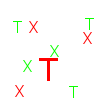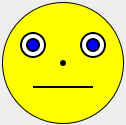In this experiment you need to determine as quickly as possible if a red "T" is present in the display.

Read more (play the experiment first!)
Description
This experiment is based on a classic study by Treisman and Gelade on which they based their Feature Integration Theory of attention. The idea behind this experiment is very simple and is all about the distinction between feature and conjunction search.
In the feature condition the target (the red "T") is different from the distractors (the other letters) in one respect: The red "T" is the only "T" in the display or it is the only red letter. This condition is easy, because you have to pay attention to only one feature (letter-shape or color) and therefore the red "T" 'pops-out'. In contrast, in the conjunction condition the target (the red "T") is intermixed with red "X"-es, red "T"-s and green "T"-s. Therefore, the target is not unique in a single feature, but only in a combination of features: It is the only stimulus which is both red and a "T".
According to Treisman and Gelade, in order to perceptually combine two features (color and letter shape, in this case) you have to attend to a stimulus. Therefore, in the conjunction condition you have to scan the letters in the display (sort of) one at a time. This means that if there are more stimuli in the display, it takes you longer (on average) to determine whether …




